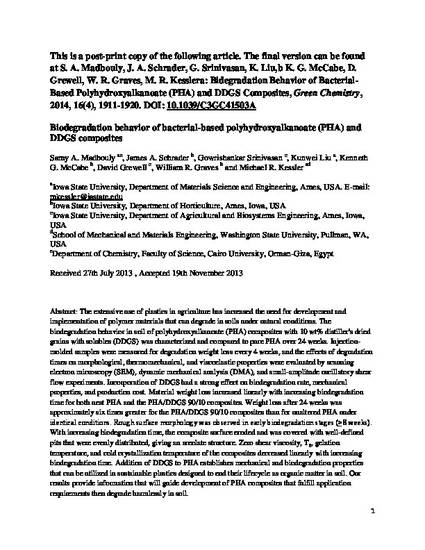
The extensive use of plastics in agriculture has increased the need for development and implementation of polymer materials that can degrade in soils under natural conditions. The biodegradation behavior in soil of polyhydroxyalkanoate (PHA) composites with 10 wt% distiller's dried grains with solubles (DDGS) was characterized and compared to pure PHA over 24 weeks. Injection-molded samples were measured for degradation weight loss every 4 weeks, and the effects of degradation times on morphological, thermomechanical, and viscoelastic properties were evaluated by scanning electron microscopy (SEM), dynamic mechanical analysis (DMA), and small-amplitude oscillatory shear flow experiments. Incorporation of DDGS had a strong effect on biodegradation rate, mechanical properties, and production cost. Material weight loss increased linearly with increasing biodegradation time for both neat PHA and the PHA/DDGS 90/10 composites. Weight loss after 24 weeks was approximately six times greater for the PHA/DDGS 90/10 composites than for unaltered PHA under identical conditions. Rough surface morphology was observed in early biodegradation stages (≥8 weeks). With increasing biodegradation time, the composite surface eroded and was covered with well-defined pits that were evenly distributed, giving an areolate structure. Zero shear viscosity, Tg, gelation temperature, and cold crystallization temperature of the composites decreased linearly with increasing biodegradation time. Addition of DDGS to PHA establishes mechanical and biodegradation properties that can be utilized in sustainable plastics designed to end their lifecycle as organic matter in soil. Our results provide information that will guide development of PHA composites that fulfill application requirements then degrade harmlessly in soil.
Available at: http://works.bepress.com/david_grewell/28/

This is a manuscript of an article published as Madbouly, Samy A., James A. Schrader, Gowrishankar Srinivasan, Kunwei Liu, Kenneth G. McCabe, David Grewell, William R. Graves, and Michael R. Kessler. "Biodegradation behavior of bacterial-based polyhydroxyalkanoate (PHA) and DDGS composites." Green Chemistry 16, no. 4 (2014): 1911-1920. DOI: 10.1039/C3GC41503A. Posted with permission.